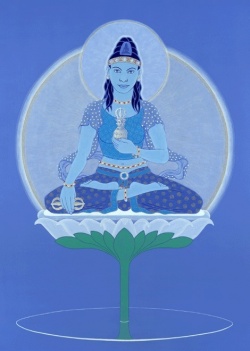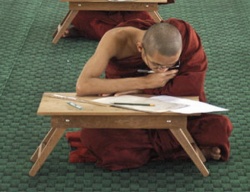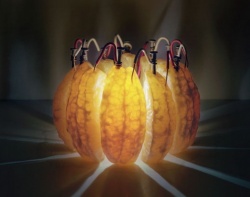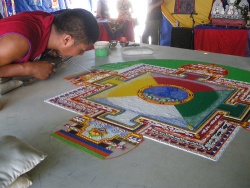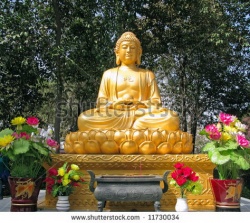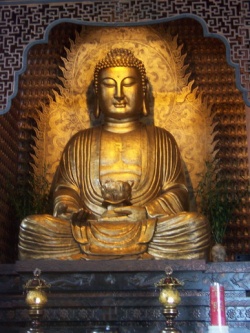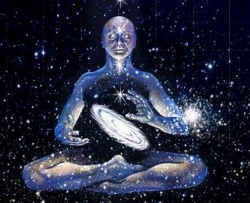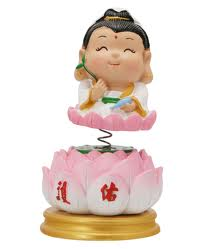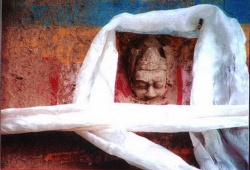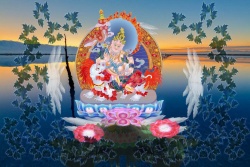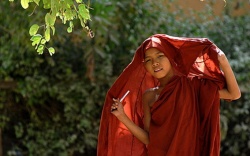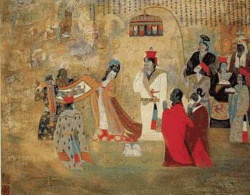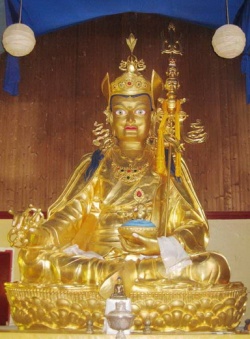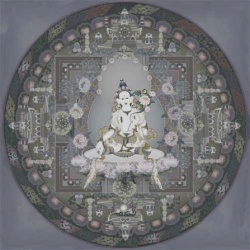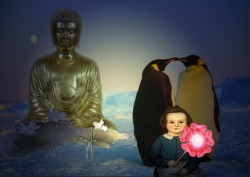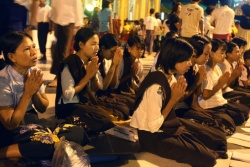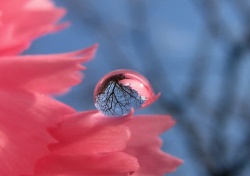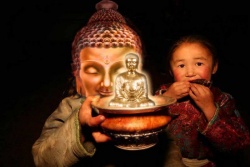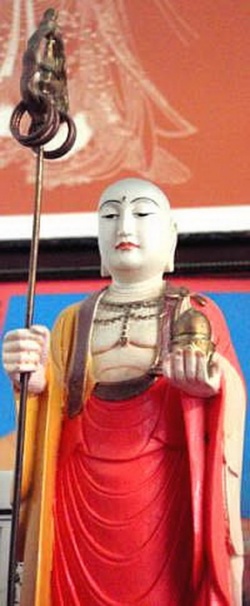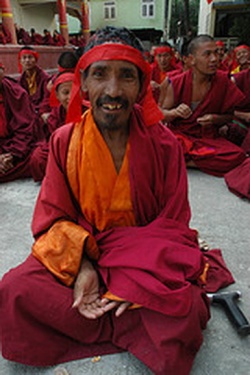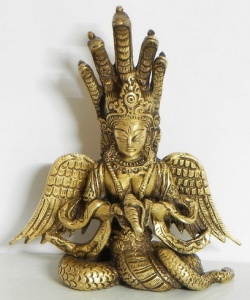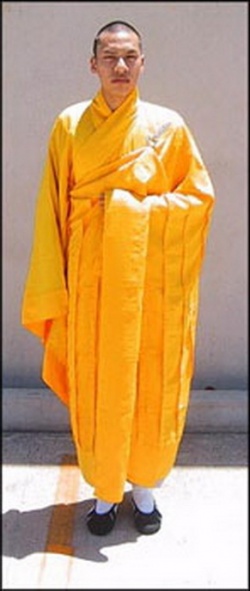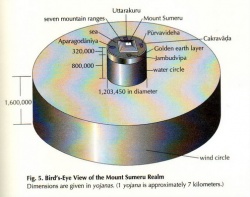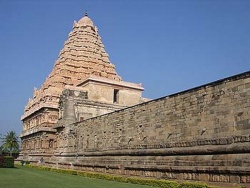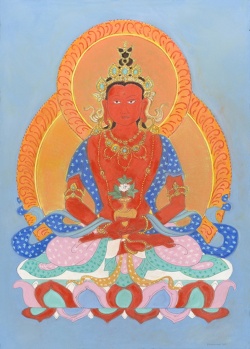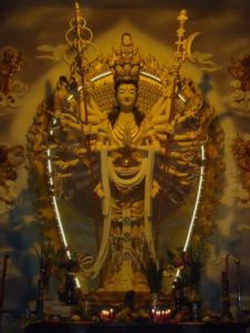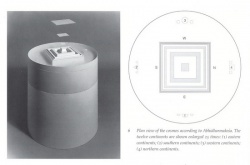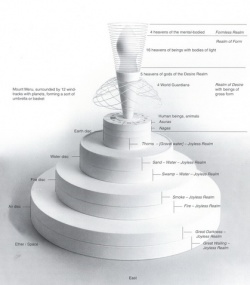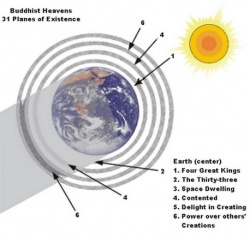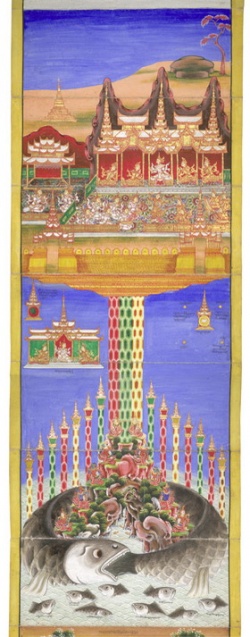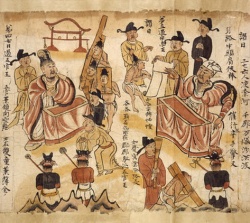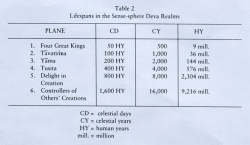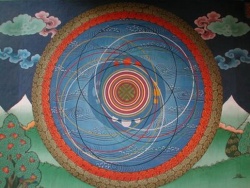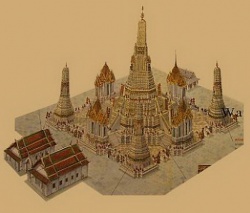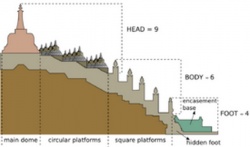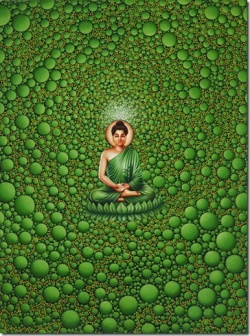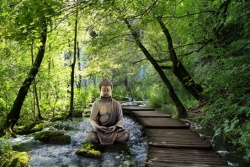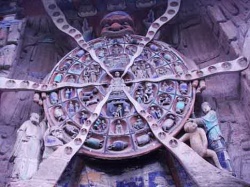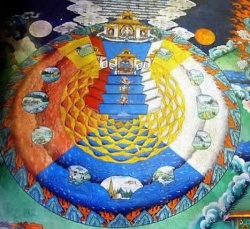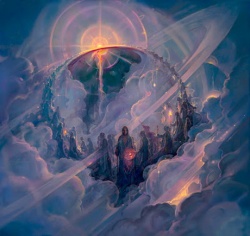Buddhist cosmology
- See also :
- See also :
Introduction
The self-consistent Buddhist cosmology which is presented in commentaries and works of Abhidharma in both Theravāda and Mahāyāna traditions, is the end-product of an analysis and reconciliation of cosmological comments found in the Buddhist sūtra and vinaya traditions.
No single sūtra sets out the entire structure of the universe.
However, in several sūtras the Buddha describes other worlds and states of being, and other sūtras describe the origin and destruction of the universe.
The synthesis of these data into a single comprehensive system must have taken place early in the history of Buddhism,
as the system described in the Pāli Vibhajyavāda tradition (represented by today's Theravādins) agrees,
despite some trivial inconsistencies of nomenclature, with the Sarvastivada tradition which is preserved by Mahāyāna Buddhists.
The picture of the world presented in Buddhist cosmological descriptions cannot be taken as a literal description of the shape of the universe.
It is inconsistent, and cannot be made consistent, with astronomical data that were already known in ancient India.
However, it is not intended to be a description of how ordinary humans perceive their world[citation needed];
rather, it is the universe as seen through the divyacakṣus (Pāli: dibbacakkhu),
the "divine eye" by which a Buddha or an arhat who has cultivated this faculty can perceive all of the other worlds
and the beings arising (being born) and passing away (dying) within them, and can tell from what state they have been reborn and into what state they will be reborn.
The cosmology has also been interpreted in a symbolical or allegorical sense (see Ten spiritual realms).
Buddhist cosmology can be divided into two related kinds: spatial cosmology, which describes the arrangement of the various worlds within the universe,
and temporal cosmology, which describes how those worlds come into existence, and how they pass away.
Spatial cosmology
Spatial cosmology can also be divided into two branches.
The vertical (or cakravāḍa) cosmology describes the arrangement of worlds in a vertical pattern, some being higher and some lower.
By contrast, the horizontal (sahasra) cosmology describes the grouping of these vertical worlds into sets of thousands, millions or billions.
Vertical cosmology
In the vertical cosmology, the universe exists of many worlds (lokāḥ) – one might say "planes" – stacked one upon the next in layers. Each world corresponds to a mental state or a state of being.
A world is not, however, a location so much as it is the beings which compose it; it is sustained by their karma and if the beings in a world all die or disappear, the world disappears too.
Likewise, a world comes into existence when the first being is born into it.
The physical separation is not so important as the difference in mental state;
humans and animals, though they partially share the same physical environments, still belong to different worlds because their minds perceive and react to those environments differently.
The vertical cosmology is divided into thirty-one planes of existence and the planes into three realms, or dhātus, each corresponding to a different type of mentality.
These three (Tridhātu) are the Ārūpyadhātu, the Rūpadhātu, and the Kāmadhātu.
The latter comprises the "five or six realms".
In some instances all of the beings born in the Ārūpyadhātu and the Rūpadhātu are informally classified as "gods" or "deities" (devāḥ),
along with the gods of the Kāmadhātu, notwithstanding the fact that the deities of the Kāmadhātu differ more from those of the Ārūpyadhātu than they do from humans.
It is to be understood that deva is an imprecise term referring to any being living in a longer-lived and generally more blissful state than humans.
Most of them are not "gods" in the common sense of the term, having little or no concern with the human world and rarely if ever interacting with it;
only the lowest deities of the Kāmadhātu correspond to the gods described in many polytheistic religions.
The term "brahmā" is used both as a name and as a generic term for one of the higher devas.
In its broadest sense, it can refer to any of the inhabitants of the Ārūpyadhātu and the Rūpadhātu.
In more restricted senses, it can refer to an inhabitant of one of the nine lower worlds of the Rūpadhātu, or in its narrowest sense, to the three lowest worlds of the Rūpadhātu.
A large number of devas use the name "Brahmā", e.g. Brahmā Sahampati, Brahmā Sanatkumāra, Baka Brahmā, etc.
It is not always clear which world they belong to, although it must always be one of the worlds of the Rūpadhātu below the Śuddhāvāsa worlds.
Formless Realm (Ārūpyadhātu)
See also: Formless Realm
The Ārūpyadhātu (Sanskrit) or Arūpaloka (Pāli) (Tib: gzugs med pa'i khams) or "Formless realm" would have no place in a purely physical cosmology, as none of the beings inhabiting it has either shape or location; and correspondingly, the realm has no location either.
This realm belongs to those devas who attained and remained in the Four Formless Absorptions (catuḥ-samāpatti) of the arūpadhyānas in a previous life,
and now enjoys the fruits (vipāka) of the good karma of that accomplishment. Bodhisattvas, however, are never born in the Ārūpyadhātu even when they have attained the arūpadhyānas.
There are four types of Ārūpyadhātu devas, corresponding to the four types of arūpadhyānas:
- Naivasaṃjñānāsaṃjñāyatana or Nevasaññānāsaññāyatana (Tib: 'du shes med 'du shes med min) "Sphere of neither perception nor non-perception".
In this sphere the formless beings have gone beyond a mere negation of perception and have attained a liminal state where they do not engage in "perception" (saṃjñā, recognition of particulars by their marks) but are not wholly unconscious.
This was the sphere reached by Udraka Rāmaputra (Pāli: Uddaka Rāmaputta), the second of the Buddha's two teachers, who considered it equivalent to enlightenment.
- Ākiṃcanyāyatana or Ākiñcaññāyatana (Tib: ci yang med) "Sphere of Nothingness" (literally "lacking anything").
In this sphere formless beings dwell contemplating upon the thought that "there is no thing".
This is considered a form of perception, though a very subtle one.
This was the sphere reached by Ārāḍa Kālāma (Pāli: Āḷāra Kālāma), the first of the Buddha's two teachers; he considered it to be equivalent to enlightenment.
- Vijñānānantyāyatana or Viññāṇānañcāyatana or more commonly the contracted form Viññāṇañcāyatana (Tib: rnam shes mtha' yas) "Sphere of Infinite Consciousness".
In this sphere formless beings dwell meditating on their consciousness (Vijñāna) as infinitely pervasive.
In this sphere formless beings dwell meditating upon space or extension (ākāśa) as infinitely pervasive.
Form Realm (Rūpadhātu)
The Rūpadhātu (Pāli: Rūpaloka; Tib: gzugs kyi khams) or "Form realm" is, as the name implies, the first of the physical realms;
its inhabitants all have a location and bodies of a sort, though those bodies are composed of a subtle substance which is of itself invisible to the inhabitants of the Kāmadhātu.
According to the Janavasabha Sutta, when a brahma (a being from the Brahma-world of the Rūpadhātu) wishes to visit a deva of the Trāyastriṃśa heaven (in the Kāmadhātu),
he has to assume a "grosser form" in order to be visible to them. There are 17-22 Rūpadhātu in Buddhism texts, the most common saying is 18.
The beings of the Form realm are not subject to the extremes of pleasure and pain, or governed by desires for things pleasing to the senses, as the beings of the Kāmadhātu are.
The bodies of Form realm beings do not have sexual distinctions.
Like the beings of the Ārūpyadhātu, the dwellers in the Rūpadhātu have minds corresponding to the dhyānas (Pāli: jhānas).
In their case it is the four lower dhyānas or rūpadhyānas.
However, although the beings of the Rūpadhātu can be divided into four broad grades corresponding to these four dhyānas, each of them is subdivided into further grades, three for each of the four dhyānas and five for the Śuddhāvāsa devas,
for a total of seventeen grades (the Theravāda tradition counts one less grade in the highest dhyānafor a total of sixteen).
Physically, the Rūpadhātu consists of a series of planes stacked on top of each other, each one in a series of steps half the size of the previous one as one descends.
In part, this reflects the fact that the devas are also thought of as physically larger on the higher planes.
The highest planes are also broader in extent than the ones lower down, as discussed in the section on Sahasra cosmology.
The height of these planes is expressed in yojanas, a measurement of very uncertain length, but sometimes taken to be about 4,000 times the height of a man, and so approximately 4.54 miles (7.31 km) or 7.32 kilometers.
Pure Abodes
The Śuddhāvāsa (Pāli: Suddhāvāsa; Tib: gnas gtsang ma) worlds, or "Pure Abodes", are distinct from the other worlds of the Rūpadhātu in that they do not house beings who have been born there through ordinary merit or meditative attainments,
but only those Anāgāmins ("Non-returners") who are already on the path to Arhat-hood and who will attain enlightenment directly from the Śuddhāvāsa worlds without being reborn in a lower plane (Anāgāmins can also be born on lower planes).
Every Śuddhāvāsa deva is therefore a protector of Buddhism.
(Brahma Sahampati, who appealed to the newly enlightened Buddha to teach, was an Anagami from a previous Buddha ).
Because a Śuddhāvāsa deva will never be reborn outside the Śuddhāvāsa worlds, no Bodhisattva is ever born in these worlds, as a Bodhisattva must ultimately be reborn as a human being.
Since these devas rise from lower planes only due to the teaching of a Buddha, they can remain empty for very long periods if no Buddha arises.
However, unlike the lower worlds, the Śuddhāvāsa worlds are never destroyed by natural catastrophe.
The Śuddhāvāsa devas predict the coming of a Buddha and, taking the guise of Brahmins, reveal to human beings the signs by which a Buddha can be recognized.
They also ensure that a Bodhisattva in his last life will see the four signs that will lead to his renunciation.
The five Śuddhāvāsa worlds are:
The highest of all the Rūpadhātu worlds, it is often used to refer to the highest extreme of the universe.
The current Śakra will eventually be born there.
The duration of life in Akaniṣṭha is 16,000 kalpas (Vibhajyavāda tradition).
Mahesvara (not to be confused with Hindu god Shiva) the ruler of the three realms of samsara is said to dwell here.
The height of this world is 167,772,160 yojanas above the Earth (approximately the distance of Saturn from Earth).
- Sudarśana or Sudassī – The "clear-seeing" devas live in a world similar to and friendly with the Akaniṣṭha world. The height of this world is 83,886,080 yojanas above the Earth. (approximately the distance of Jupiter from Earth)
- Sudṛśa or Sudassa – The world of the "beautiful" devas are said to be the place of rebirth for five kinds of anāgāmins. The height of this world is 41,943,040 yojanas above the Earth.
- Atapa or Atappa – The world of the "untroubled" devas, whose company those of lower realms wish for. The height of this world is 20,971,520 yojanas above the Earth.(approximately the distance of Sun from Earth)
- Avṛha or Aviha – The world of the "not falling" devas, perhaps the most common destination for reborn Anāgāmins.
Many achieve arhatship directly in this world, but some pass away and are reborn in sequentially higher worlds of the Pure Abodes until they are at last reborn in the Akaniṣṭha world.
These are called in Pāli uddhaṃsotas, "those whose stream goes upward".
The duration of life in Avṛha is 1,000 kalpas (Vibhajyavāda tradition).
The height of this world is 10,485,760 yojanas above the Earth.(approximately the distance of Mars from Earth)
Bṛhatphala worlds
The mental state of the devas of the Bṛhatphala worlds corresponds to the fourth dhyāna, and is characterized by equanimity (upekṣā).
The Bṛhatphala worlds form the upper limit to the destruction of the universe by wind at the end of a mahākalpa (see Temporal cosmology below), that is, they are spared such destruction.
- Asaññasatta (Sanskrit: Asaṃjñasattva) (Vibhajyavāda tradition only) – "Unconscious beings", devas who have attained a high dhyāna (similar to that of the Formless Realm), and, wishing to avoid the perils of perception, have achieved a state of non-perception in which they endure for a time.
After a while, however, perception arises again and they fall into a lower state.
- Bṛhatphala or Vehapphala (Tib: 'bras bu che) – Devas "having great fruit".
Their lifespan is 500 mahākalpas. (Vibhajyavāda tradition).
Some Anāgāmins are reborn here.
The height of this world is 5,242,880 yojanas above the Earth.(approximately the distance of Venus from Earth)
- Puṇyaprasava (Sarvāstivāda tradition only; Tib: bsod nams skyes) – The world of the devas who are the "offspring of merit".
The height of this world is 2,621,440 yojanas above the Earth.
The height of this world is 1,310,720 yojanas above the Earth.
Śubhakṛtsna worlds
The mental state of the devas of the Śubhakṛtsna worlds corresponds to the third dhyāna, and is characterized by a quiet joy (sukha).
These devas have bodies that radiate a steady light.
The Śubhakṛtsna worlds form the upper limit to the destruction of the universe by water at the end of a mahākalpa (see Temporal cosmology below), that is, the flood of water does not rise high enough to reach them.
- Śubhakṛtsna or Subhakiṇṇa / Subhakiṇha (Tib: dge rgyas) – The world of devas of "total beauty".
Their lifespan is 64 mahākalpas (some sources: 4 mahākalpas) according to the Vibhajyavāda tradition.
64 mahākalpas is the interval between destructions of the universe by wind, including the Śubhakṛtsna worlds.
The height of this world is 655,360 yojanas above the Earth.
- Apramāṇaśubha or Appamāṇasubha (Tib: tshad med dge) – The world of devas of "limitless beauty".
Their lifespan is 32 mahākalpas (Vibhajyavāda tradition).
They possess "faith, virtue, learning, munificence and wisdom". The height of this world is 327,680 yojanas above the Earth.
- Parīttaśubha or Parittasubha (Tib: dge chung) – The world of devas of "limited beauty".
Their lifespan is 16 mahākalpas.
The height of this world is 163,840 yojanas above the Earth.
Ābhāsvara worlds
The mental state of the devas of the Ābhāsvara worlds corresponds to the second dhyāna, and is characterized by delight (prīti) as well as joy (sukha); the Ābhāsvara devas are said to shout aloud in their joy, crying aho sukham! ("Oh joy!").
These devas have bodies that emit flashing rays of light like lightning.
They are said to have similar bodies (to each other) but diverse perceptions.
The Ābhāsvara worlds form the upper limit to the destruction of the universe by fire at the end of a mahākalpa (see Temporal cosmology below), that is, the column of fire does not rise high enough to reach them.
After the destruction of the world, at the beginning of the vivartakalpa, the worlds are first populated by beings reborn from the Ābhāsvara worlds.
The lifespan of the Ābhāsvara devas is 8 mahākalpas (others: 2 mahākalpas).
Eight mahākalpas is the interval between destructions of the universe by water, which includes the Ābhāsvara worlds.
The height of this world is 81,920 yojanas above the Earth.
- Apramāṇābha or Appamāṇābha (Tib: tshad med 'od) – The world of devas of "limitless light", a concept on which they meditate.
Their lifespan is 4 mahākalpas. The height of this world is 40,960 yojanas above the Earth.
- Parīttābha or Parittābha (Tib: 'od chung) – The world of devas of "limited light".
Their lifespan is 2 mahākalpas. The height of this world is 20,480 yojanas above the Earth.
Brahmā worlds
See also: Brahma
The mental state of the devas of the Brahmā worlds corresponds to the first dhyāna, and is characterized by observation (vitarka) and reflection (vicāra) as well as delight (prīti) and joy (sukha).
The Brahmā worlds, together with the other lower worlds of the universe, are destroyed by fire at the end of a mahākalpa (see Temporal cosmology below).
- Mahābrahmā (Tib: tshangs pa chen po) – the world of Great Brahmā", believed by many to be the creator of the world, and having as his titles "Brahmā, [[Great [rahmā]], the Conqueror, the Unconquered, the All-Seeing, All-Powerful, the Lord, the Maker and Creator, the Ruler, Appointer and Orderer, Father of All That Have Been and Shall Be."
According to the Brahmajāla Sutta (DN.1), a Mahābrahmā is a being from the Ābhāsvara worlds who falls into a lower world through exhaustion of his merits and is reborn alone in the Brahma-world; forgetting his former existence, he imagines himself to have come into existence without cause.
Note that even such a high-ranking deity has no intrinsic knowledge of the worlds above his own. Mahābrahmā is 1 ½ yojanas tall. His lifespan variously said to be 1 kalpa (Vibhajyavāda tradition) or 1 ½ kalpas long (Sarvāstivāda tradition),
although it would seem that it could be no longer than ¾ of a mahākalpa, i.e., all of the mahākalpa except for the Saṃvartasthāyikalpa, because that is the total length of time between the rebuilding of the lower world and its destruction.
It is unclear what period of time "kalpa" refers to in this case. The height of this world is 10,240 yojanas above the Earth.
- Brahmapurohita (Tib: tshangs 'khor) – the "Ministers of Brahmā" are beings, also originally from the Ābhāsvara worlds, that are born as companions to Mahābrahmā after he has spent some time alone.
Since they arise subsequent to his thought of a desire for companions, he believes himself to be their creator, and they likewise believe him to be their creator and lord.
They are 1 yojana in height and their lifespan is variously said to be ½ of a kalpa (Vibhajyavāda tradition) or a whole kalpa (Sarvāstivāda tradition).
If they are later reborn in a lower world, and come to recall some part of their last existence, they teach the doctrine of Brahmā as creator as a revealed truth.
The height of this world is 5,120 yojanas above the Earth.
- Brahmapāriṣadya or Brahmapārisajja (Tib: tshangs ris) – the "Councilors of Brahmā" or the devas "belonging to the assembly of Brahmā".
They are also called Brahmakāyika, but this name can be used for any of the inhabitants of the Brahma-worlds.
They are half a yojana in height and their lifespan is variously said to be ⅓ of a kalpa (Vibhajyavāda tradition) or ½ of a kalpa (Sarvāstivāda tradition). The height of this world is 2,560 yojanas above the Earth.
Desire Realm (Kāmadhātu)
See also: Desire realm
The beings born in the Kāmadhātu (Pāli: Kāmaloka; Tib: 'dod pa'i khams) differ in degree of happiness, but they are all, other than arhats and Buddhas, under the domination of Māra and are bound by sensual desire, which causes them suffering.
Heavens
The following four worlds are bounded planes. each 80,000 yojanas square, which float in the air above the top of Mount Sumeru.
Although all of the worlds inhabited by devas (that is, all the worlds down to the Cāturmahārājikakāyika world and sometimes including the Asuras) are sometimes called "heavens", in the western sense of the word the term best applies to the four worlds listed below:
- Parinirmita-vaśavartin or Paranimmita-vasavatti (Tib: gzhan 'phrul dbang byed) – The heaven of devas "with power over (others') creations".
These devas do not create pleasing forms that they desire for themselves, but their desires are fulfilled by the acts of other devas who wish for their favor.
The ruler of this world is called Vaśavartin (Pāli: Vasavatti), who has longer life, greater beauty, more power and happiness and more delightful sense-objects than the other devas of his world.
This world is also the home of the devaputra (being of divine race) called Māra, who endeavors to keep all beings of the Kāmadhātu in the grip of sensual pleasures.
Māra is also sometimes called Vaśavartin, but in general these two dwellers in this world are kept distinct.
The beings of this world are 4,500 feet (1,400 m) tall and live for 9,216,000,000 years (Sarvāstivāda tradition).
The height of this world is 1,280 yojanas above the Earth.
- Nirmāṇarati or Nimmānaratī (Tib: 'phrul dga' )– The world of devas "delighting in their creations".
The devas of this world are capable of making any appearance to please themselves.
The lord of this world is called Sunirmita (Pāli Sunimmita); his wife is the rebirth of Visākhā, formerly the chief of the upāsikās (female lay devotees) of the Buddha.
The beings of this world are 3,750 feet (1,140 m) tall and live for 2,304,000,000 years (Sarvāstivāda tradition).
The height of this world is 640 yojanas above the Earth.
This world is best known for being the world in which a Bodhisattva lives before being reborn in the world of humans.
Until a few thousand years ago, the Bodhisattva of this world was Śvetaketu (Pāli: Setaketu), who was reborn as Siddhārtha, who would become the Buddha Śākyamuni;
since then the Bodhisattva has been Nātha (or Nāthadeva) who will be reborn as Ajita and will become the Buddha Maitreya (Pāli Metteyya).
While this Bodhisattva is the foremost of the dwellers in Tuṣita, the ruler of this world is another deva called Santuṣita (Pāli: Santusita).
The beings of this world are 3,000 feet (910 m) tall and live for 576,000,000 years (Sarvāstivāda tradition).
The height of this world is 320 yojanas above the Earth.
- Yāma (Tib: 'thab bral) – Sometimes called the "heaven without fighting", because it is the lowest of the heavens to be physically separated from the tumults of the earthly world.
These devas live in the air, free of all difficulties.
Its ruler is the deva Suyāma; according to some, his wife is the rebirth of Sirimā, a courtesan of Rājagṛha in the Buddha's time who was generous to the monks.
The beings of this world are 2,250 feet (690 m) tall and live for 144,000,000 years (Sarvāstivāda tradition). The height of this world is 160 yojanas above the Earth.
Worlds of Sumeru
See also Sumeru
The world-mountain of Sumeru is an immense, strangely shaped peak which arises in the center of the world, and around which the Sun and Moon revolve.
Its base rests in a vast ocean, and it is surrounded by several rings of lesser mountain ranges and oceans.
The three worlds listed below are all located on or around Sumeru: the Trāyastriṃśa devas live on its peak, the Cāturmahārājikakāyika devas live on its slopes, and the Asuras live in the ocean at its base.
Sumeru and its surrounding oceans and mountains are the home not just of these deities, but also vast assemblies of beings of popular mythology who only rarely intrude on the human world.
- Trāyastriṃśa) or Tāvatiṃsa (Tib: sum cu rtsa gsum pa) – The world "of the Thirty-three (devas)" is a wide flat space on the top of Mount Sumeru, filled with the gardens and palaces of the devas.
Its ruler is Śakra devānām indra, "Śakra, lord of the devas". Besides the eponymous Thirty-three devas, many other devas and supernatural beings dwell here, including the attendants of the devas and many apsarases (nymphs).
The beings of this world are 1,500 feet (460 m) tall and live for 36,000,000 years (Sarvāstivāda tradition) or 3/4 of a yojana tall and live for 30,000,000 years (Vibhajyavāda tradition).
The height of this world is 80 yojanas above the Earth.
- Cāturmahārājikakāyika or Cātummahārājika (Tib: rgyal chen bzhi) – The world "of the Four Great Kings" is found on the lower slopes of Mount Sumeru, though some of its inhabitants live in the air around the mountain.
Its rulers are the four Great Kings of the name, Virūḍhaka, Dhṛtarāṣṭra, Virūpākṣa, and their leader Vaiśravaṇa.
The devas who guide the Sun and Moon are also considered part of this world, as are the retinues of the four kings, composed of Kumbhāṇḍas (dwarfs), Gandharvas (fairies), Nāgas (dragons) and Yakṣas (goblins).
The beings of this world are 750 feet (230 m) tall and live for 9,000,000 years (Sarvāstivāda tradition) or 90,000 years (Vibhajyavāda tradition).
The height of this world is from sea level up to 40 yojanas above the Earth.
- Asura (Tib: lha ma yin) – The world of the Asuras is the space at the foot of Mount Sumeru, much of which is a deep ocean. It is not the Asuras' original home,
but the place they found themselves after they were hurled, drunken, from Trāyastriṃśa where they had formerly lived.
The Asuras are always fighting to regain their lost kingdom on the top of Mount Sumeru, but are unable to break the guard of the Four Great Kings.
The Asuras are divided into many groups, and have no single ruler, but among their leaders are Vemacitrin (Pāli: Vepacitti) and Rāhu.
Earthly realms
- Manuṣyaloka (Tib: mi) – This is the world of humans and human-like beings who live on the surface of the earth. The mountain-rings that engird Sumeru are surrounded by a vast ocean, which fills most of the world.
The ocean is in turn surrounded by a circular mountain wall called Cakravāḍa (Pāli: Cakkavāḷa) which marks the horizontal limit of the world. In this ocean there are four continents which are, relatively speaking, small islands in it.
Because of the immenseness of the ocean, they cannot be reached from each other by ordinary sailing vessels, although in the past, when the cakravartin kings ruled, communication between the continents was possible by means of the treasure called the cakraratna (Pāli cakkaratana), which a cakravartin and his retinue could use to fly through the air between the continents.
The four continents are:
- Jambudvīpa or Jambudīpa is located in the south and is the dwelling of ordinary human beings.
It is said to be shaped "like a cart", or rather a blunt-nosed triangle with the point facing south.
(This description probably echoes the shape of the coastline of southern India.)
It is 10,000 yojanas in extent (Vibhajyavāda tradition) or has a perimeter of 6,000 yojanas (Sarvāstivāda tradition) to which can be added the southern coast of only 3 ½ yojanas' length.
The continent takes its name from a giant Jambu tree (Syzygium cumini), 100 yojanas tall, which grows in the middle of the continent. Every continent has one of these giant trees.
All Buddhas appear in Jambudvīpa. The people here are five to six feet tall and their length of life varies between 80,000 and 10 years.
- Pūrvavideha or Pubbavideha is located in the east, and is shaped like a semicircle with the flat side pointing westward (i.e., towards Sumeru).
It is 7,000 yojanas in extent (Vibhajyavāda tradition) or has a perimeter of 6,350 yojanas of which the flat side is 2,000 yojanas long (Sarvāstivāda tradition).
Its tree is the acacia. The people here are about 12 feet (3.7 m) tall and they live for 250 years.
- Aparagodānīya or Aparagoyāna is located in the west, and is shaped like a circle with a circumference of about 7,500 yojanas (Sarvāstivāda tradition). The tree of this continent is a giant Kadamba tree. The human inhabitants of this continent do not live in houses but sleep on the ground. They are about 24 feet (7.3 m) tall and they live for 500 years.
- Uttarakuru is located in the north, and is shaped like a square.
It has a perimter of 8,000 yojanas, being 2,000 yojanas on each side.
This continent's tree is called a kalpavṛkṣa (Pāli: kapparukkha) or kalpa-tree, because it lasts for the entire kalpa.
The inhabitants of Uttarakuru are said to be extraordinarily wealthy.
They do not need to labor for a living, as their food grows by itself, and they have no private property.
They have cities built in the air. They are about 48 feet (15 m) tall and live for 1,000 years, and they are under the protection of Vaiśravaṇa.
- Tiryagyoni-loka or Tiracchāna-yoni (Tib: dud 'gro) – This world comprises all members of the animal kingdom that are capable of feeling suffering, regardless of size.
- Pretaloka or Petaloka (Tib: yi dwags) – The pretas, or "hungry ghosts", are mostly dwellers on earth, though due to their mental state they perceive it very differently from humans.
They live for the most part in desert and waste places.
Hells (Narakas)
See also: Naraka
Naraka or Niraya (Tib: dmyal ba) is the name given to one of the worlds of greatest suffering, usually translated into English as "hell" or "purgatory".
As with the other realms, a being is born into one of these worlds as a result of his karma, and resides there for a finite length of time until his karma has achieved its full result,
after which he will be reborn in one of the higher worlds as the result of an earlier karma that had not yet ripened.
The mentality of a being in the hells corresponds to states of extreme fear and helpless anguish in humans.
Physically, Naraka is thought of as a series of layers extending below Jambudvīpa into the earth.
There are several schemes for counting these Narakas and enumerating their torments.
One of the more common is that of the Eight Cold Narakas and Eight Hot Narakas.
- Arbuda – the "blister" Naraka
- Nirarbuda – the "burst blister" Naraka
- Aṭaṭa – the Naraka of shivering
- Hahava – the Naraka of lamentation
- Huhuva – the Naraka of chattering teeth
- Utpala – the "blue lotus" Naraka
- Padma – the "lotus" Naraka
- Mahāpadma – the "great lotus" Naraka
Each lifetime in these Narakas is twenty times the length of the one before it.
- Sañjīva – the "reviving" Naraka. Life in this Naraka is 162*1010 years long.
- Kālasūtra – the "black thread" Naraka. Life in this Naraka is 1296*1010 years long.
- Saṃghāta – the "crushing" Naraka. Life in this Naraka is 10,368*1010 years long.
- Raurava – the "screaming" Naraka. Life in this Naraka is 82,944*1010 years long.
- Mahāraurava – the "great screaming" Naraka. Life in this Naraka is 663,552*1010 years long.
- Tapana – the "heating" Naraka. Life in this Naraka is 5,308,416*1010 years long.
- Pratāpana – the "great heating" Naraka. Life in this Naraka is 42,467,328*1010 years long.
- Avīci – the "uninterrupted" Naraka. Life in this Naraka is 339,738,624*1010 years long.
The foundations of the earth
All of the structures of the earth, Sumeru and the rest, extend downward to a depth of 80,000 yojanas below sea level – the same as the height of Sumeru above sea level.
Below this is a layer of "golden earth", a substance compact and firm enough to support the weight of Sumeru.
It is 320,000 yojanas in depth and so extends to 400,000 yojanas below sea level.
The layer of golden earth in turn rests upon a layer of water, which is 8,000,000 yojanas in depth, going down to 8,400,000 yojanas below sea level.
Below the layer of water is a "circle of wind", which is 16,000,000 yojanas in depth and also much broader in extent, supporting 1,000 different worlds upon it.
Sahasra cosmology
While the vertical cosmology describes the arrangement of the worlds vertically, the sahasra (Sanskrit: "thousand") cosmology describes how they are grouped horizontally.
The four heavens of the Kāmadhātu, as mentioned, occupy a limited space no bigger than the top of Mount Sumeru.
The three Brahmā-worlds, however, stretch out as far as the mountain-wall of Cakravāḍa, filling the entire sky.
This whole group of worlds, from Mahābrahmā down to the foundations of water, constitutes a single world-system.
It corresponds to the extent of the universe that is destroyed by fire at the end of one mahākalpa.
Above Mahābrahmā are the Ābhāsvara worlds.
These are not only higher but also wider in extent; they cover 1,000 separate world-systems, each with its own Sumeru, Cakravāḍa, Sun, Moon, and four continents. This system of 1,000 worlds is called a sāhasra-cūḍika-lokadhātu, or "small chiliocosm".
It corresponds to the extent of the universe that is destroyed by water at the end of 8 mahākalpas.
Above the Ābhāsvara worlds are the Śubhakṛtsna worlds, which cover 1,000 chiliocosms, or 1,000,000 world-systems.
This larger system is called a dvisāhasra-madhyama-lokadhātu, or "medium dichiliocosm".
It corresponds to the extent of the universe that is destroyed by wind at the end of 64 mahākalpas.
Likewise, above the Śubhakṛtsna worlds, the Śuddhāvāsa and Bṛhatphala worlds cover 1,000 dichiliocosms, or 1,000,000,000 world-systems. This largest grouping is called a trisāhasra-mahāsāhasra-lokadhātu or "great trichiliocosm".
Temporal cosmology
Buddhist temporal cosmology describes how the universe comes into being and is dissolved.
Like other Indian cosmologies, it assumes an infinite span of time and is cyclical.
This does not mean that the same events occur in identical form with each cycle, but merely that, as with the cycles of day and night or summer and winter, certain natural events occur over and over to give some structure to time.
The basic unit of time measurement is the mahākalpa or "Great Eon".
The exact length of this time in human years is never defined exactly, but it is meant to be very long, to be measured in billions of years if not longer.
A mahākalpa is divided into four kalpas or "eons", each distinguished from the others by the stage of evolution of the universe during that kalpa.
The four kalpas are:
- Vivartakalpa "Eon of evolution" – during this kalpa the universe comes into existence.
- Vivartasthāyikalpa "Eon of evolution-duration" – during this kalpa the universe remains in existence in a steady state.
- Saṃvartakalpa "Eon of dissolution" – during this kalpa the universe dissolves.
- Saṃvartasthāyikalpa "Eon of dissolution-duration" – during this kalpa the universe remains in a state of emptiness.
Each one of these kalpas is divided into twenty antarakalpas (Pāli antarakappa, "inside eons") each of about the same length. For the Saṃvartasthāyikalpa this division is merely nominal, as nothing changes from one antarakalpa to the next; but for the other three kalpas it marks an interior cycle within the kalpa.
Vivartakalpa
The Vivartakalpa begins with the arising of the primordial wind, which begins the process of building up the structures of the universe that had been destroyed at the end of the last mahākalpa.
As the extent of the destruction can vary, the nature of this evolution can vary as well, but it always takes the form of beings from a higher world being born into a lower world.
The example of a Mahābrahmā being the rebirth of a deceased Ābhāsvara deva is just one instance of this, which continues throughout the Vivartakalpa until all the worlds are filled from the Brahmaloka down to Naraka. During the Vivartakalpa the first humans appear;
they are not like present-day humans, but are beings shining in their own light, capable of moving through the air without mechanical aid, living for a very long time, and not requiring sustenance; they are more like a type of lower deity than present-day humans are.
Over time, they acquire a taste for physical nutriment, and as they consume it, their bodies become heavier and more like human bodies;
they lose their ability to shine, and begin to acquire differences in their appearance, and their length of life decreases.
They differentiate into two sexes and begin to become sexually active.
Then greed, theft and violence arise among them, and they establish social distinctions and government and elect a king to rule them, called Mahāsammata, "the great appointed one".
Some of them begin to hunt and eat the flesh of animals, which have by now come into existence.
Vivartasthāyikalpa
First antarakalpa
The Vivartasthāyikalpa begins when the first being is born into Naraka, thus filling the entire universe with beings.
During the first antarakalpa of this eon, human lives are declining from a vast but unspecified number of years (but at least several tens of thousands of years) toward the modern lifespan of less than 100 years.
At the beginning of the antarakalpa, people are still generally happy.
They live under the rule of a universal monarch or "wheel-turning king" (cakravartin), who conquer.
The Mahāsudassana-sutta tells of the life of a cakravartin king, Mahāsudassana (Sanskrit: Mahāsudarśana) who lived for 336,000 years.
The Cakkavatti-sīhanāda-sutta tells of a later dynasty of cakravartins, Daḷhanemi (Sanskrit: Dṛḍhanemi) and five of his descendants, who had a lifespan of over 80,000 years.
The seventh of this line of cakravartins broke with the traditions of his forefathers, refusing to abdicate his position at a certain age, pass the throne on to his son, and enter the life of a śramaṇa.
As a result of his subsequent misrule, poverty increased; as a result of poverty, theft began; as a result of theft, capital punishment was instituted; and as a result of this contempt for life, murders and other crimes became rampant.
The human lifespan now quickly decreased from 80,000 to 100 years, apparently decreasing by about half with each generation (this is perhaps not to be taken literally),
while with each generation other crimes and evils increased: lying, greed, hatred, sexual misconduct, disrespect for elders.
During this period, according to the Mahāpadāna-sutta three of the four Buddhas of this antarakalpa lived: Krakucchanda Buddha (Pāli: Kakusandha),
at the time when the lifespan was 40,000 years; Kanakamuni Buddha (Pāli: Konāgamana) when the lifespan was 30,000 years; and Kāśyapa Buddha (Pāli: Kassapa) when the lifespan was 20,000 years.
Our present time is taken to be toward the end of the first antarakalpa of this Vivartasthāyikalpa, when the lifespan is less than 100 years, after the life of Śākyamuni Buddha (Pāli: Sakyamuni), who lived to the age of 80.
The remainder of the antarakalpa is prophesied to be miserable:
lifespans will continue to decrease, and all the evil tendencies of the past will reach their ultimate in destructiveness.
People will live no longer than ten years, and will marry at five; foods will be poor and tasteless; no form of morality will be acknowledged.
The most contemptuous and hateful people will become the rulers. Incest will be rampant. Hatred between people, even members of the same family, will grow until people think of each other as hunters do of their prey.
Eventually a great war will ensue, in which the most hostile and aggressive will arm themselves and go out to kill each other.
The less aggressive will hide in forests and other secret places while the war rages.
This war marks the end of the first antarakalpa.
Second antarakalpa
At the end of the war, the survivors will emerge from their hiding places and repent their evil habits.
As they begin to do good, their lifespan increases, and the health and welfare of the human race will also increase with it.
After a long time, the descendants of those with a 10-year lifespan will live for 80,000 years, and at that time there will be a cakravartin king named Saṅkha.
During his reign, the current bodhisattva in the Tuṣita heaven will descend and be reborn under the name of Ajita.
He will enter the life of a śramaṇa and will gain perfect enlightenment as a Buddha; and he will then be known by the name of Maitreya (Pāli: Metteyya).
After Maitreya's time, the world will again worsen, and the lifespan will gradually decrease from 80,000 years to 10 years again, each antarakalpa being separated from the next by devastating war, with peaks of high civilization and morality in the middle.
After the 19th antarakalpa, the lifespan will increase to 80,000 and then not decrease, because the Vivartasthāyikalpa will have come to an end.
Saṃvartakalpa
The Saṃvartakalpa begins when beings cease to be born in Naraka.
This cessation of birth then proceeds in reverse order up the vertical cosmology, i.e., pretas then cease to be born, then animals, then humans, and so on up to the realms of the deities.
When these worlds as far as the Brahmaloka are devoid of inhabitants, a great fire consumes the entire physical structure of the world.
It burns all the worlds below the Ābhāsvara worlds. When they are destroyed, the Saṃvartasthāyikalpa begins.
Saṃvartasthāyikalpa
There is nothing to say about the Saṃvartasthāyikalpa, since nothing happens in it below the Ābhāsvara worlds.
It ends when the primordial wind begins to blow and build the structure of the worlds up again.
Other destructions
The destruction by fire is the normal type of destruction that occurs at the end of the Saṃvartakalpa.
But every eighth mahākalpa, after seven destructions by fire, there is a destruction by water.
This is more devastating, as it eliminates not just the Brahma worlds but also the Ābhāsvara worlds.
Every sixty-fourth mahākalpa, after 56 destructions by fire and 7 destructions by water, there is a destruction by wind.
This is the most devastating of all, as it also destroys the Śubhakṛtsna worlds.
The higher worlds are never destroyed.
Mahayana views
Mahayana Buddhism accepted the cosmology as above.
But they believe there are pure land worlds where buddhas and bodhisattvas teach sentient beings in human forms.
A cosmology with some difference is further explained in the Worlds, chapter 5 of Avatamsaka Sutra.
Source
Dharmapunk.webs.com
Space
Triloka: The Three Planes of Existence in Samsara
1. The Immaterial World (arupa-loka).
Consists of four realms that are accessible to those who pass away while meditating in the formless jhanas.
2. The Fine-Material World (rupa-loka)
Consists of sixteen realms whose inhabitants (the devas) experience extremely refined degrees of mental pleasure.
These realms are accessible to those who have attained at least some level of jhana and who have thereby managed to (temporarily) suppress hatred and ill-will.
They are said to possess extremely refined bodies of pure light.
The highest of these realms, the Pure Abodes, are accessible only to those who have attained to "non-returning," the third stage of Awakening.
The Fine-Material World and the Immaterial World together constitute the "heavens" (sagga).
3. The Sensuous World (kama-loka)
Consists of eleven realms in which experience — both pleasurable and not — is dominated by the five senses.
Seven of these realms are favorable destinations, and include our own human realm as well as several realms occupied by devas.
The lowest realms are the four "bad" destinations, which include the animal and hell realms.
I. The Immaterial World (arupa-loka)
| Realm | Comments | Cause of rebirth here |
|---|---|---|
| (31)Neither-perception-nor-non-perception (nevasaññanasaññayatanupaga deva) | The inhabitants of these realms are possessed entirely of mind. Having no physical body, they are unable to hear Dhamma teachings. | Fourth formless jhana |
| (30)Nothingness (akiñcaññayatanupaga deva) | Third formless jhana | |
| (29)Infinite Consciousness (viññanañcayatanupaga deva) | Second formless jhana | |
| (28)Infinite Space (akasanañcayatanupaga deva) | First formless jhana |
II. The Fine-Material World (rupa-loka)
| Realm | Comments | Cause of rebirth here |
|---|---|---|
| (27)Peerless devas (akanittha deva) | These are the five Pure Abodes (suddhavasa), which are accessible only to non-returners (anagami) and arahants. Beings who become non-returners in other planes are reborn here, where they attain arahantship.
Among its inhabitants is Brahma Sahampati, who begs the Buddha to teach Dhamma to the world (SN 6.1). |
Fourth jhana. See, for example, AN 4.123. |
| (26)Clear-sighted devas (sudassi deva) | ||
| (25)Beautiful devas (sudassa deva) | ||
| (24)Untroubled devas (atappa deva) | ||
| (23)Devas not Falling Away (aviha deva) | ||
| (22)Unconscious beings (asaññasatta) | Only body is present; no mind. | |
| (21)Very Fruitful devas (vehapphala deva) | Beings in these planes enjoy varying degrees of jhanic bliss. | |
| (20)Devas of Refulgent Glory (subhakinna deva) | Third jhana (highest degree). See, for example, AN 4.123. | |
| (19)Devas of Unbounded Glory (appamanasubha deva) | Third jhana (medium degree) | |
| (18)Devas of Limited Glory (parittasubha deva) | Third jhana (minor degree) | |
| (17)Devas of Streaming Radiance (abhassara deva) | Second jhana (highest degree). See, for example, AN 4.123. | |
| (16)Devas of Unbounded Radiance (appamanabha deva) | Second jhana (medium degree) | |
| (15)Devas of Limited Radiance (parittabha deva) | Second jhana (minor degree) | |
| (14)Great Brahmas (Maha brahma) | One of this realm's most famous inhabitants is the Great Brahma, a deity whose delusion leads him to regard himself as the all-powerful, all-seeing creator of the universe (DN 11). | First jhana (highest degree) |
| (13)Ministers of Brahma (brahma-purohita deva) | Beings in these planes enjoy varying degrees of jhanic bliss. | First jhana (medium degree) |
| (12)Retinue of Brahma (brahma-parisajja deva) | First jhana (minor degree). See, for example, AN 4.123. |
III. The Sensuous World (kama-loka)
| Realm | Comments | Cause of rebirth here |
|---|---|---|
| Happy Destinations (sugati) | ||
| (11)Devas Wielding Power over the Creation of Others (paranimmita-vasavatti deva) | These devas enjoy sense pleasures created by others for them. Mara, the personification of delusion and desire, lives here. | * Ten wholesome actions (MN 41)
* The development of virtue and wisdom (AN 10.177) |
| (10)Devas Delighting in Creation (nimmanarati deva) | These devas delight in the sense objects of their own creation. | |
| (9)Contented devas (tusita deva) | A realm of pure delight and gaiety. Bodhisattvas abide here prior to their final human birth. This is where the bodhisatta Maitreya (Metteya), the next Buddha, is said to dwell. | |
| (8)Yama devas (yama deva) | These devas live in the air, free of all difficulties. | |
| (7)The Thirty-three Gods (tavatimsa deva) | Sakka, a devotee of the Buddha, presides over this realm. Many devas dwelling here live in mansions in the air. | |
| (6)Devas of the Four Great Kings (catumaharajika deva) | Home of the gandhabbas, the celestial musicians, and the yakkhas, tree spirits of varying degrees of ethical purity. The latter are analogous to the goblins, trolls, and fairies of Western fairy tales. | |
| (5)Human beings (manussa loka) | You are here (for now). Rebirth as a human being is extraordinarily rare (SN 56.48). It is also extraordinarily precious, as its unique balance of pleasure and pain (SN 35.135) facilitates the development of virtue and wisdom to the degree necessary to set one free from the entire cycle of rebirths. |
* The development of virtue and wisdom (AN 10.177)
* The attainment of stream-entry (sotapatti) guarantees that all future rebirths will be in the human or higher realms. |
| States of Deprivation (apaya) | ||
| (4)Asuras (asura) | The demons — "titans" — that dwell here are engaged in relentless conflict with each other. | * Ten unwholesome actions (MN 10) |
| (3) Hungry Shades/Ghosts (peta loka) | Ghosts and unhappy spirits wander hopelessly about this realm, searching in vain for sensual fulfillment. | * Ten unwholesome actions (MN 10)
* Lack of virtue, holding to wrong views (AN 10.177) |
| (2) Animals (tiracchana yoni) | This realm includes all the non-human forms of life that are visible to us under ordinary circumstances: animals, insects, fish, birds, worms, etc. | * Ten unwholesome actions (MN 10)
* Lack of virtue, holding to wrong views. If one is generous to monks and nuns, however, one may be reborn as an "ornamented" animal (i.e., a bird with bright plumage; a horse with attractive markings, etc.; AN 10.177). * Behaving like an animal (MN 57) |
| (1) Hell (niraya) | These are realms of unimaginable suffering and anguish (described in graphic detail in MN 129 and 130). Should not be confused with the eternal hell proposed by other religions, since one's time here is — as it is in every realm — temporary. | * Ten unwholesome actions (Saleyyaka Sutta: The Brahmans of Sala|MN 10]])
* Lack of virtue, holding to wrong views (AN 10.177) * Murdering your parents, murdering an arahant, injuring the Buddha, or creating a schism in the Sangha (Parikuppa Sutta: In Agony|AN 5.129]]) * Being quarrelsome and annoying to others (Dhammacariya Sutta: Wrong Conduct|Snp II.6]]) |
Time
Time in Buddhism is usually measured in kalpas, which is Sanskrit for "aeon".
A "Great Kalpa" (Skt. "Mahakalpa") consists of four Asankhyeya-Kalpas (uncountable kalpas):
- 1. Kalpa of formation (Vivarta)
- 2. Kalpa of existence (Vivatasiddha)
- 3. Kalpa of destruction (Samvarta)
- 4. Kalpa of emptiness (Samvartasiddha)
Each of these four Kalpas are also subdivided into twenty Antarakalpa (Small Kalpas), so that a Mahakalpa consists of 80 Antarakalpa.
A kalpa generally indicates the length of time between the periodic formation, existence, destruction, and non-existence of worlds or universes.
There are different interpretations of the measurement of a kalpa in Buddhism, but it is generally agreed to be a very long, almost uncountable period of time.
There are small, medium, great, and incalculable kalpas.
Kalachakra literally means "Time-Wheel".
The phrase "as outside, so within" or "as above, so below" is often found within Kalchakra tantra.
It emphasizes the relationship of the outer universe with the inner physical and mental processes of sentient beings, describing the concurrence of human and cosmic phenomena with time.
It also builds a complete astrological system.
Kalachakra is among the other practices of the Highest Yoga Tantra (Anuttarayoga).
However it is also called the "clear" tantra, because its language is unusually clear and straightforward as compared to most other Highest Yoga Tantras.
The Kalachakra teaching as taught by Shakyamuni Buddha is called the Root Kalachakra Tantra, the Kalachakra Mulatantra or Paramadibuddhatantra of 12,000 lines.
The Shambhala King Suchandra wrote a commentary called the Explanatory Tantra in 60,000 lines.
However, both these texts never reached us.
There are three cycles within the Kalachakra tantra:
Outer Kalachakra refers to the outer world which is the vessel supporting sentient beings.
It is compounded by the six elements of
earth,
water,
fire,
air,
space and
wisdom;
and all objects of smell, sight, taste, touch, sound and Dharma.
Another division follows the cosmic buildup of the universe; the center made up by Mt. Meru, surrounded by the four continents and the eight subcontinents.
Around its' peak circle the planets of our solar system, the moon, sun, stars and so forth.
This system is dictated by time cycles of years, months and days; also described as "the procession of the external solar and lunar days."
Inner Kalachakra consists of the body and mind of living beings, the psychophysical aggregates, the sensory and psychic capacities so forth.
This includes the six types of living beings
(devas,
asuras,
munusyas,
tiryaks,
pretas and
narakas),
the six energy centers (chakras) of the body, the ten vital energies, the energy channels, the eight drops that carry the instincts of the two obscurations, and so forth.
Inner Kalachakra deals with the astrological relationships of the internal energies, chakras, channels and drops to mental and emotional states, physical organs, and transformation processes.
The basic theory is that on the body's subtle energies normally move in synchronicity with the cycles of the planets.
This movement of planetary energies within the body is the subject of the astrology of the Internal Kalachakra.
In other words, Inner and Outer Kalachakra include all the living beings and the external world in an astrological relation to the living beings.
The relation is similar to the Greek expression "as above, so below".
Alternative (or 'Other') Kalachakra describes the spiritual method leading to enlightenment in the form of Kalachakra.
It describes the initiation, the Generation and Completion Stage Yogas.
These two Yoga stages are the methods that have the power to purify the Outer and Inner Kalachakras (living beings and the universe).
Outer Kalachakras and Inner Kalachakras are the bases to be purified, whereas Alternative Kalachakra refers to the yogic practices that effect this purification and produce the three purified results.
Kalachakra mantra: OM HA KSA MA LA VA RA YA SVA HA
